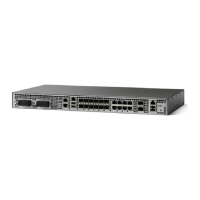27
Cisco IOS XE 3S Release Notes for the Cisco ASR 903 Router
OL-26630-12
Chapter Restrictions and Caveats in Cisco IOS XE 3.6S Releases
Caveats in Cisco IOS XE 3.6S Releases
–
The configuration contains 48 EFPs with 24 EFPs in a given bridge domain
–
SSM is enabled on the local and a remote router
–
The router sends an IGMP join to a single multicast group.
Workaround: There is no workaround.
• CSCty87424
Symptoms: The router experiences a drop in forwarded packets on an MLPPP bundle.
Conditions: Occurs when the bundle is using 64% or more of the available bandwidth and an MTU
value is configured on the bundle.
Workaround: There is no workaround.
• CSCty90425
Symptoms: The router crashes and reboots.
Conditions: Occurs when you perform a longevity test with traffic soaking while using Ethernet
features such as EoMPLS, VPLS, CFM, or Y1731.
Workaround: There is no workaround.
• CSCty92979
Symptoms: The router loses ARP table entries after a network link flaps.
Conditions: Occurs following a network link flap when the router’s ARP table contains entries for
next-hop neighbors connected over a router bridge domain interface.
Workaround: There is no workaround.
• CSCty93985
Symptoms: Egress QoS policies do not take effect on an EFP interface.
Conditions: Occurs when you apply an egress QoS policy to an interface configured with more than
37 EFPs.
Workaround: There is no workaround.
• CSCty94081
Symptoms: The router displays an EgBridgeError_0 error when sending multicast traffic.
Conditions: Occurs in the following conditions:
–
There are 40 bridge domain interfaces (BDIs) sending IGMP joins to a single multicast group.
–
There are more than 40 OIFs and 24 EVCs in each bridge domain.
Workaround: There is no workaround.
• CSCty94437
Symptoms: The router crashes during RSP switchover or bootup.
Conditions: Occurs when L2VPN services are passing bidirectional traffic on the router and you
perform a reload or RSP switchover.
Workaround: There is no workaround.
• CSCty96326
Symptoms: The router crashes.
Conditions: Occurs during bootup when the router is running BFD and CFM sessions that are
offloaded to hardware.

